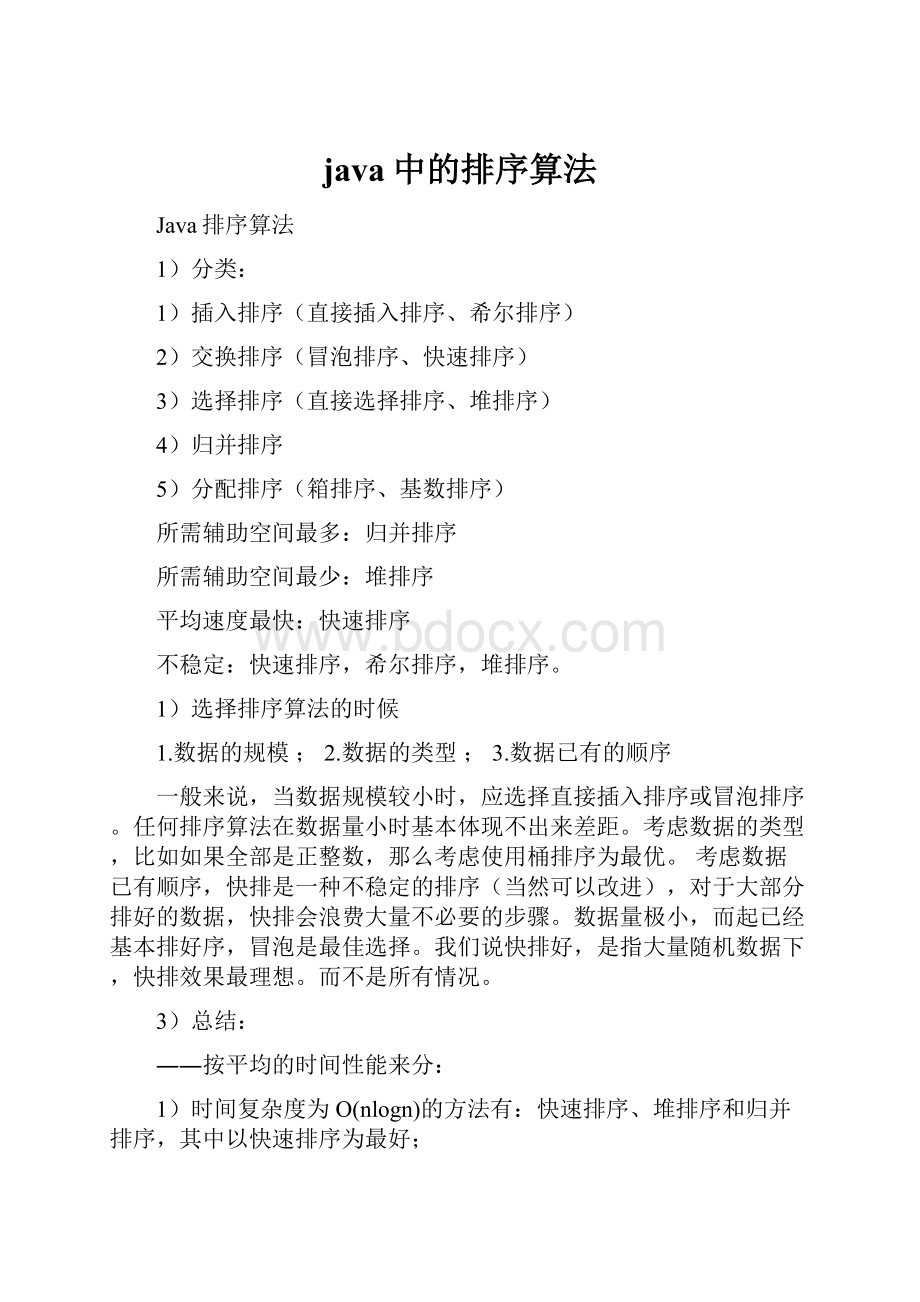java中的排序算法.docx
《java中的排序算法.docx》由会员分享,可在线阅读,更多相关《java中的排序算法.docx(17页珍藏版)》请在冰豆网上搜索。

java中的排序算法
Java排序算法
1)分类:
1)插入排序(直接插入排序、希尔排序)
2)交换排序(冒泡排序、快速排序)
3)选择排序(直接选择排序、堆排序)
4)归并排序
5)分配排序(箱排序、基数排序)
所需辅助空间最多:
归并排序
所需辅助空间最少:
堆排序
平均速度最快:
快速排序
不稳定:
快速排序,希尔排序,堆排序。
1)选择排序算法的时候
1.数据的规模;2.数据的类型;3.数据已有的顺序
一般来说,当数据规模较小时,应选择直接插入排序或冒泡排序。
任何排序算法在数据量小时基本体现不出来差距。
考虑数据的类型,比如如果全部是正整数,那么考虑使用桶排序为最优。
考虑数据已有顺序,快排是一种不稳定的排序(当然可以改进),对于大部分排好的数据,快排会浪费大量不必要的步骤。
数据量极小,而起已经基本排好序,冒泡是最佳选择。
我们说快排好,是指大量随机数据下,快排效果最理想。
而不是所有情况。
3)总结:
――按平均的时间性能来分:
1)时间复杂度为O(nlogn)的方法有:
快速排序、堆排序和归并排序,其中以快速排序为最好;
2)时间复杂度为O(n2)的有:
直接插入排序、起泡排序和简单选择排序,其中以直接插入为最好,特别是对那些对关键字近似有序的记录序列尤为如此;
3)时间复杂度为O(n)的排序方法只有,基数排序。
当待排记录序列按关键字顺序有序时,直接插入排序和起泡排序能达到O(n)的时间复杂度;而对于快速排序而言,这是最不好的情况,此时的时间性能蜕化为O(n2),因此是应该尽量避免的情况。
简单选择排序、堆排序和归并排序的时间性能不随记录序列中关键字的分布而改变。
――按平均的空间性能来分(指的是排序过程中所需的辅助空间大小):
1)所有的简单排序方法(包括:
直接插入、起泡和简单选择)和堆排序的空间复杂度为O
(1);
2)快速排序为O(logn),为栈所需的辅助空间;
3)归并排序所需辅助空间最多,其空间复杂度为O(n);
4)链式基数排序需附设队列首尾指针,则空间复杂度为O(rd)。
――排序方法的稳定性能:
1)稳定的排序方法指的是,对于两个关键字相等的记录,它们在序列中的相对位置,在排序之前和经过排序之后,没有改变。
2)当对多关键字的记录序列进行LSD方法排序时,必须采用稳定的排序方法。
3)对于不稳定的排序方法,只要能举出一个实例说明即可。
4)快速排序,希尔排序和堆排序是不稳定的排序方法。
4)插入排序:
包括直接插入排序,希尔插入排序。
直接插入排序:
将一个记录插入到已经排序好的有序表中。
1,sorted数组的第0个位置没有放数据。
2,从sorted第二个数据开始处理:
如果该数据比它前面的数据要小,说明该数据要往前面移动。
首先将该数据备份放到sorted的第0位置当哨兵。
然后将该数据前面那个数据后移。
然后往前搜索,找插入位置。
找到插入位置之后讲第0位置的那个数据插入对应位置。
O(n*n),当待排记录序列为正序时,时间复杂度提高至O(n)。
希尔排序(缩小增量排序diminishingincrementsort):
先将整个待排记录序列分割成若干个子序列分别进行直接插入排序,待整个序列中的记录基本有序时,再对全体记录进行一次直接插入排序。
插入排序Java代码:
publicclassInsertionSort{
//插入排序:
直接插入排序,希尔排序
publicvoidstraightInsertionSort(double[]sorted){
intsortedLen=sorted.length;
for(intj=2;jif(sorted[j]sorted[0]=sorted[j];//先保存一下后面的那个
sorted[j]=sorted[j-1];//前面的那个后移。
intinsertPos=0;
for(intk=j-2;k>=0;k–){
if(sorted[k]>sorted[0]){
sorted[k+1]=sorted[k];
}else{
insertPos=k+1;
break;
}
}
sorted[insertPos]=sorted[0];
}
}
}
publicvoidshellInertionSort(double[]sorted,intinc){
intsortedLen=sorted.length;
for(intj=inc+1;j
if(sorted[j]sorted[0]=sorted[j];//先保存一下后面的那个
intinsertPos=j;
for(intk=j-inc;k>=0;k-=inc){
if(sorted[k]>sorted[0]){
sorted[k+inc]=sorted[k];
//数据结构课本上这个地方没有给出判读,出错:
if(k-inc<=0){
insertPos=k;
}
}else{
insertPos=k+inc;
break;
}
}
sorted[insertPos]=sorted[0];
}
}
}
publicvoidshellInsertionSort(double[]sorted){
int[]incs={7,5,3,1};
intnum=incs.length;
intinc=0;
for(intj=0;jinc=incs[j];
shellInertionSort(sorted,inc);
}
}
publicstaticvoidmain(String[]args){
Randomrandom=newRandom(6);
intarraysize=21;
double[]sorted=newdouble[arraysize];
System.out.print("BeforeSort:
");
for(intj=1;jsorted[j]=(int)(random.nextDouble()*100);
System.out.print((int)sorted[j]+"");
}
System.out.println();
InsertionSortsorter=newInsertionSort();
//sorter.straightInsertionSort(sorted);
sorter.shellInsertionSort(sorted);
System.out.print("AfterSort:
");
for(intj=1;jSystem.out.print((int)sorted[j]+"");
}
System.out.println();
}
}
5)交换排序:
包括冒泡排序,快速排序。
冒泡排序法:
该算法是专门针对已部分排序的数据进行排序的一种排序算法。
如果在你的数据清单中只有一两个数据是乱序的话,用这种算法就是最快的排序算法。
如果你的数据清单中的数据是随机排列的,那么这种方法就成了最慢的算法了。
因此在使用这种算法之前一定要慎重。
这种算法的核心思想是扫描数据清单,寻找出现乱序的两个相邻的项目。
当找到这两个项目后,交换项目的位置然后继续扫描。
重复上面的操作直到所有的项目都按顺序排好。
快速排序:
通过一趟排序,将待排序记录分割成独立的两个部分,其中一部分记录的关键字均比另一部分记录的关键字小,则可分别对这两部分记录继续进行排序,以达到整个序列有序。
具体做法是:
使用两个指针low,high,初值分别设置为序列的头,和序列的尾,设置pivotkey为第一个记录,首先从high开始向前搜索第一个小于pivotkey的记录和pivotkey所在位置进行交换,然后从low开始向后搜索第一个大于pivotkey的记录和此时pivotkey所在位置进行交换,重复知道low=high了为止。
交换排序Java代码:
publicclassExchangeSort{
publicvoidBubbleExchangeSort(double[]sorted){
intsortedLen=sorted.length;
for(intj=sortedLen;j>0;j–){
intend=j;
for(intk=1;kdoubletempB=sorted[k];
sorted[k]=sorted[k]sorted[k]:
sorted[k+1];
if(Math.abs(sorted[k]-tempB)>10e-6){
sorted[k+1]=tempB;
}
}
}
}
publicvoidQuickExchangeSortBackTrack(double[]sorted,
intlow,inthigh){
if(lowintpivot=findPivot(sorted,low,high);
QuickExchangeSortBackTrack(sorted,low,pivot-1);
QuickExchangeSortBackTrack(sorted,pivot+1,high);
}
}
publicintfindPivot(double[]sorted,intlow,inthigh){
sorted[0]=sorted[low];
while(lowwhile(low=sorted[0])–high;
sorted[low]=sorted[high];
while(low<="sorted[0])++low;sorted[high]=sorted[low];
}
sorted[low]=sorted[0];
returnlow;
}
publicstaticvoidmain(String[]args){
Randomrandom=newRandom(6);
intarraysize=21;
double[]sorted=newdouble[arraysize];
System.out.print("BeforeSort:
");
for(intj=1;jsorted[j]=(int)(random.nextDouble()*100);
System.out.print((int)sorted[j]+"");
}
System.out.println();
ExchangeSortsorter=newExchangeSort();
//sorter.BubbleExchangeSort(sorted);
sorter.QuickExchangeSortBackTrack(sorted,1,arraysize-1);
System.out.print("AfterSort:
");
for(intj=1;jSystem.out.print((int)sorted[j]+"");
}
System.out.println();
}
}
6)选择排序:
分为直接选择排序,堆排序
直接选择排序:
第i次选取i到array.Length-1中间最小的值放在i位置。
堆排序:
首先,数组里面用层次遍历的顺序放一棵完全二叉树。
从最后一个非终端结点往前面调整,直到到达根结点,这个时候除根节点以外的所有非终端节点都已经满足堆得条件了,于是需要调整根节点使得整个树满足堆得条件,于是从根节点开始,沿着它的儿子们往下面走(最大堆沿着最大的儿子走,最小堆沿着最小的儿子走)。
主程序里面,首先从最后一个非终端节点开始调整到根也调整完,形成一个heap,然后将heap的根放到后面去(即:
每次的树大小会变化,但是root都是在1的位置,以方便计算儿子们的index,所以如果需要升序排列,则要逐步大顶堆。
因为根节点被一个个放在后面去了。
降序排列则要建立小顶堆)
代码中的问题:
有时候第2个和第3个顺序不对(原因还没搞明白到底代码哪里有错)
选择排序Java代码:
publicclassSelectionSort{
publicvoidstraitSelectionSort(double[]sorted){
intsortedLen=sorted.length;
for(intj=1;jintjMin=getMinIndex(sorted,j);
exchange(sorted,j,jMin);
}
}
publicvoidexchange(double[]sorted,inti,intj){
intsortedLen=sorted.length;
if(i=0&&j>=0){
doubletemp=sorted[i];
sorted[i]=sorted[j];
sorted[j]=temp;
}
}
publicintgetMinIndex(double[]sorted,inti){
intsortedLen=sorted.length;
intminJ=1;
doublemin=Double.MAX_VALUE;
for(intj=i;jif(sorted[j]min=sorted[j];
minJ=j;
}
}
returnminJ;
}
publicvoidheapAdjust(double[]sorted,intstart,intend){
if(startdoubletemp=sorted[start];
//这个地方jfor(intj=2*start;jif(j+110e-6){
++j;
}
if(temp<=sorted[j]){
break;
}
sorted[start]=sorted[j];
start=j;
}
sorted[start]=temp;
}
}
publicvoidheapSelectionSort(double[]sorted){
intsortedLen=sorted.length;
for(inti=sortedLen/2;i>0;i–){
heapAdjust(sorted,i,sortedLen);
}
for(inti=sortedLen;i>1;–i){
exchange(sorted,1,i);
heapAdjust(sorted,1,i-1);
}
}
publicstaticvoidmain(String[]args){
Randomrandom=newRandom(6);
intarraysize=9;
double[]sorted=newdouble[arraysize];
System.out.print(“BeforeSort:
”);
for(intj=1;jsorted[j]=(int)(random.nextDouble()*100);
System.out.print((int)sorted[j]+"");
}
System.out.println();
SelectionSortsorter=newSelectionSort();
//sorter.straitSelectionSort(sorted);
sorter.heapSelectionSort(sorted);
System.out.print("AfterSort:
");
for(intj=1;jSystem.out.print((int)sorted[j]+"");
}
System.out.println();
}
}
7)归并排序:
将两个或两个以上的有序表组合成一个新的有序表。
归并排序要使用一个辅助数组,大小跟原数组相同,递归做法。
每次将目标序列分解成两个序列,分别排序两个子序列之后,再将两个排序好的子序列merge到一起。
归并排序Java代码:
publicclassMergeSort{
privatedouble[]bridge;//辅助数组
publicvoidsort(double[]obj){
if(obj==null){
thrownewNullPointerException("
Theparamcannotbenull!
");
}
bridge=newdouble[obj.length];//初始化中间数组
mergeSort(obj,0,obj.length-1);//归并排序
bridge=null;
}
privatevoidmergeSort(double[]obj,intleft,intright){
if(leftintcenter=(left+right)/2;
mergeSort(obj,left,center);
mergeSort(obj,center+1,right);
merge(obj,left,center,right);
}
}
privatevoidmerge(double[]obj,intleft,
intcenter,intright){
intmid=center+1;
intthird=left;
inttmp=left;
while(left<=center&&mid<=right){
//从两个数组中取出小的放入中间数组
if(obj[left]-obj[mid]<=10e-6){
bridge[third++]=obj[left++];
}else{
bridge[third++]=obj[mid++];
}
}
//剩余部分依次置入中间数组
while(mid<=right){
bridge[third++]=obj[mid++];
}
while(left<=center){
bridge[third++]=obj[left++];
}
//将中间数组的内容拷贝回原数组
copy(obj,tmp,right);
}
privatevoidcopy(double[]obj,intleft,intright)
{
while(left<=right){
obj[left]=bridge[left];
left++;
}
}
publicstaticvoidmain(String[]args){
Randomrandom=newRandom(6);
intarraysize=10;
double[]sorted=newdouble[arraysize];
System.out.print("BeforeSort:
");
for(intj=0;jsorted[j]=(int)(random.nextDouble()*100);
System.out.print((int)sorted[j]+"");
}
System.out.println();
MergeSortsorter=newMergeSort();
sorter.sort(sorted);
System.out.print("AfterSort:
");
for(intj=0;jSystem.out.print((int)sorted[j]+"");
}
System.out.println();
}
}
8)基数排序:
使用10个辅助队列,假设最大数的数字位数为x,则一共做x次,从个位数开始往前,以第i位数字的大小为依据,将数据放进辅助队列,搞定之后回收。
下次再以高一位开始的数字位为依据。
以Vector作辅助队列,基数排序的Java代码:
publicclassRadixSort{
privateintkeyNum=-1;
privateVectorutil;
publicvoiddistribute(double[]sorted,intnth){
if(nth<=keyNum&&nth>0){
util=newVector();
for(intj=0;j<10;j++){
Vectortemp=newVector();
util.add(temp);
}
for(intj=0;jintindex=getNthDigit(sorted[j],nth);
util.get(index).add(sorted[j]);
}
}
}
publicintgetNthDigit(doublenum,intnth){
Stringnn=Integer.toString((int)num);
intlen=nn.length();
if(len>=nth){
returnCharacter.getNumericValue(nn.charAt(len-nth));
}else{
return0;
}
}
publicvoidcollect(double[]sorted){
intk=0;
for(intj=0;j<10;j++){
intlen=util.get(j).size();
if(len>0){
for(inti=0;isorted[k++]=util.get(j).get(i);
}
}
}
util=null;
}
publicintgetKeyNum(double[]sorted){
doublemax=Double.MIN_VALUE;
for(intj=0;jif(sorted[j]>max){
max=sorted[j];
}
}
returnInteger.toString((int)max).length();
}
publicvoidradixSort(double[]sorted){
if(keyNum==-1){
keyNum=get